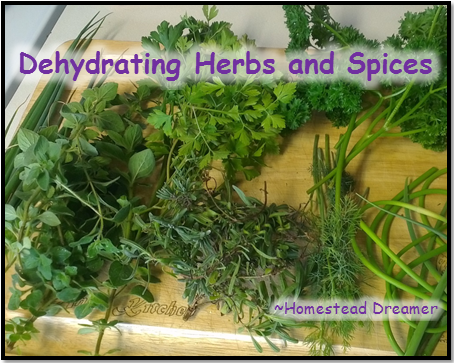While I was out harvesting the first garlic scapes of the year, I decided it would also be a good time to harvest some other herbs and spices I have growing. The price of spices is incredibly high here in rural Alaska. I learned how easy it was to grow basil last year and haven’t had to buy any since!
In the title picture above we have (from left to right) green onions, oregano, parsley, lavender, cilantro, dill, and some garlic scapes. I have dehydrated green onions before and still have some from last year. They make a wonderful addition to soups, stews, and casseroles. The whole experience last year prompted me to increase my variety and try to attain self sufficiency, at least in this area. In addition to the obvious savings and quality of growing my own herbs and spices, it is also something that can be bartered with both now and in the event of a disaster. Imagine having zero spices to cook with for a month, and then here comes some freshly dried oregano? What would YOU trade?
There are many ways to dehydrate herbs and spices; bundled and hanging, in a dehydrator, or in the oven. You could even do it over a wood stove! I use my Excalibur dehydrator since it makes it so easy; just place the herbs on the trays, set your temperature and the time to run and walk away! For air and oven drying, a little more attention is required and I will go into some basic details behind the methods.
Air drying your herbs is done by tying small bundles of the herbs together and then hanging them from the ceiling, special herb drying racks, or anything that will allow air flow around the bundles. It is important that the bundles are not laying in their side, or up against a wall. It can cause wilting, rot, or otherwise ruin the overall bundle. Air flow is more important than heat. You will want to let them initially dry for 24 hours, maybe checking on them after 12. Drying times depend on what you have bundled. Parsley will generally dry faster than lavender. Use your best judgement.
Oven drying is another method that many people prefer. To oven dry, your oven is put on its lowest possible setting and the door is kept slightly open. You want to dry the herbs, not cook them. A paper towel is placed under the single layer of herbs to help draw out moisture. Oven drying is less time consuming than air drying but it requires you to be there and check the herbs every 3-5 minutes to make sure they aren’t getting overly hot (therefore cooking). You will need to rotate the herbs to get an even and thorough drying. If you are using a non-electric oven, pay close attention to potential hot spots. Also, make sure the paper towel is not in a position where it could catch fire.
Dehydrator drying is straightforward and to the point. The temps used is around 95-110 degrees F. I generally set the first timer for 4-6 hours and then check. If there is still moisture in the leaves or stems, I will put another 2-4 hours of time on the clock. After that pretty much everything is dry and ready to be stored.
Dehydrating Herbs and Spices is a great way to save money on a superior product!
Remember, the key is to get all the excess moisture out. If there is any lingering, it could cause mold and sickness. People living in humid areas will face more challenges than those who live in arid climates. No matter which method you use, let the herbs get to room temperature and check again for moisture before storing them in air tight containers, vacuum seal bags, or whatever you choose to put them in.
BONUS IDEA: I have seen people take fresh herbs and put them into ice cube trays, then pour water into it and freeze. When they want to add some fresh, tasty herbs and spices, they just pull out a cube or two and viola! I have used this to a small extent and found it to be a really great way to keep some ‘fresh’ herbs on hand all year long.
Do you grow herbs? What method do you use to preserve them? Give us a comment below or back on Facebook!
Post may contain affiliate links





You can also dice your fresh herbs up very small, put in ice cube trays, pour melted butter over and freeze. This is awesome on baked salmon,halibut and potatoes!
That sounds incredibly delicious! Thanks for the comment, and sharing the butter idea! 🙂